Mom's Garam Masala is a sensational spice blend that infuses a world of flavor into any dish. This garam masala recipe has been passed down through generations and is still the cornerstone of our family’s food traditions. Sharing our special recipe here is my attempt to preserve this legacy.
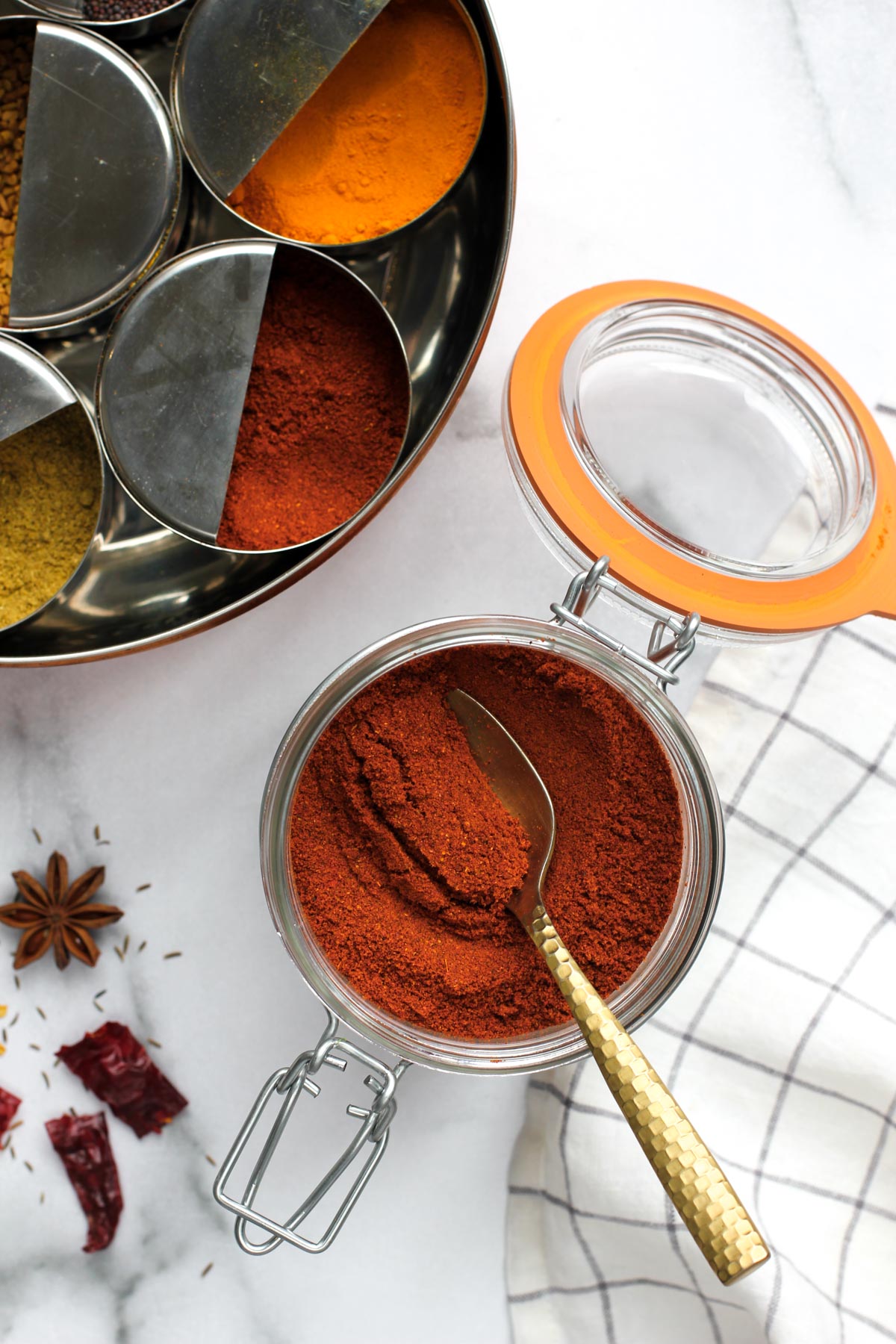
Note: Original post published in Oct 2017 has been updated with new photos and a video.
Jump to:
Writing It Down
If you’ve cooked with your family, you’re probably familiar with having recipes passed down by word of mouth or by watching and learning. That’s why it was so important for me to finally document this recipe in detail for my children, extended family…and future generations!
Heirloom Recipe
Every family has its own version of garam masala. With anywhere from 5 to 25 warming spices included, it’s easy to imagine how many variations of garam masala there can be! In many Maharashtrian families, this kind of masala is also referred to as 'Goda masala' which typically also has coconut in it. My mom uses this garam masala to make delicious Indian dishes like chicken curry, stuffed eggplant, or black-eyed peas curry, just to name a few!

A Family Project
In the summer of 2017 when my Mom visited me, I asked her to bring all of the whole spices that she uses to make her garam masala. She was thrilled to bring them, together we had a great time exploring and comprehending each spice. These were also some of the most treasured moments for the mother-daughter duo, recollecting family anecdotes from generations past.
My mom slow-roasted each individual spice in a small pan, with a little bit of oil. Roasting helps get rid of any moisture in the spices making them easier to grind. As she continued to roast, a nostalgic warm-earthy-sweet-peppery aroma filled my kitchen! It transported me back in time, not only to my childhood home but also to my grandma's kitchen where we were lucky to spend so much time cooking together.
Building Up Slowly
If you’re just starting out with building your spice collection or making spice blends at home–I’ve got you. My simple 5-ingredient Garam Masala is the perfect place to start. Use this simplified recipe for everything from traditional curries to modern dishes like masala chicken burgers, spicy mac and cheese, masala fries, and crisp air-fried okra.
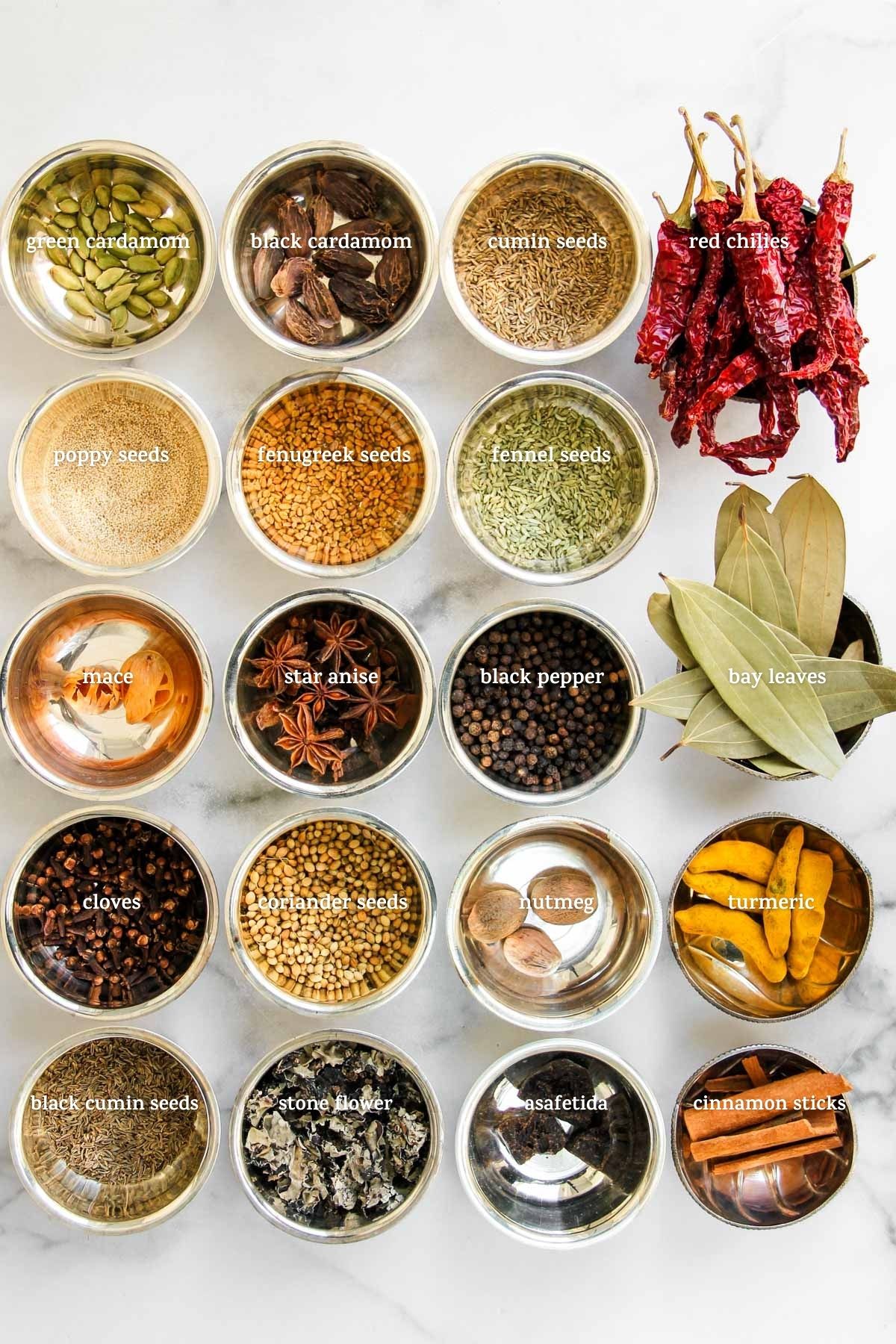
List of the spices
With my mom's help, I was able to map the Marathi spice names to the English ones; with the hope of passing this down as one of the legacies for my children and my extended family.
- asafetida {hing} - used as a digestive aid, asafetida has a strong odor that mellows out into a garlic-onion flavor
- bay leaves {tamal patra} - aromatic bay leaves with impressive health benefits which include detoxifying the body
- black peppercorns {miri} - hot pungent spice, black pepper helps improve the stomach's ability to digest foods and promotes intestinal health
- black cardamom {badi velchi} - often referred to as the queen of spices, black cardamom gives a smoky flavor to curries
- cardamom {velchi} - sweet and invigorating spice, green cardamom pods adds a fresh flavor to many recipes
- cumin seeds {jeera} - with its earthy, musky flavor; cumin seeds are one of the most popular spice
- black cumin seeds {shah jeera} - slightly bitter than cumin seeds; black cumin seeds are a rich source of dietary fiber
- cinnamon {daalchini} - sweet-spicy flavored cinnamon sticks enhance the flavors in many dishes
- cloves {lavang} - with a distinct and undeniable warmth, cloves are one of the most powerful spices with intense flavors
- coriander seeds {dhana} - Citrusy flavored coriander seeds add warm and nutty flavors
- dried red chilies {lal mirchi} - with a rich earthy flavor, chilies add perfect heat and color to foods
- fennel seeds {badishep} - lightly sweet and licorice-flavored, fennel seeds are a good digestion aid
- fenugreek seeds {methi} - bitter-tasting fenugreek seeds help control diabetes and have diverse benefits for skin, hair, and health
- mace {jaipatri} - mace is the outer covering of nutmeg that adds subtle and delicate flavors
- nutmeg {jaiphal} - sweet and pungent nutmeg adds a warm note to savory dishes
- poppy seeds {khuskhus} - adds nutty flavors and khuskhus is also a good source of minerals
- star anise {badyaan} - star anise adds a sweet-licorice flavor to curries
- stone flower {dagadphool} - with a strong earthy aroma this anti-inflammatory kalpasi spice is also dominant in South Indian Chettinad cuisine
- turmeric {halkund} - with a mild woody flavor, turmeric is a superfood with natural anti-inflammatory properties
Preparing and Roasting Whole Spices
- Using a mortar and pestle break the whole turmeric, whole asafetida, and whole nutmeg into smaller pieces, one at a time. Set these three spices aside. Remove the stems of the red chilies.
- Heat a few drops of oil in a heavy-bottomed pan or a skillet. Add the red chilies and dry roast them on medium-low heat for 2 to 5 minutes stirring frequently as they get aromatic. Take out the roasted chilies in a large bowl (photos 1 - 4)
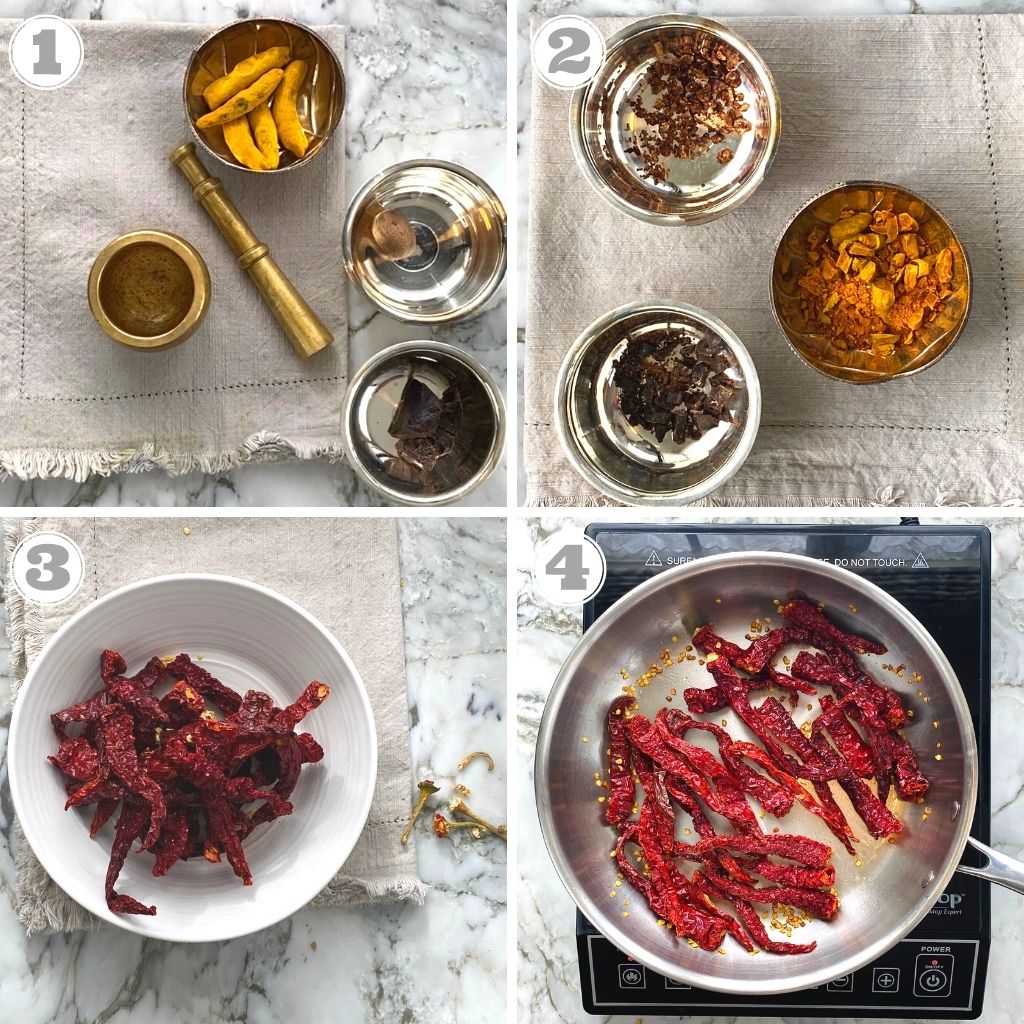
- Next, add the coriander seeds to the pan and roast until they get aromatic making sure not to brown them. Take out the coriander seeds and lay on top of the roasted chilies. Repeat the roasting process with turmeric, asafetida, and nutmeg, adding a few drops of oil to the pan before toasting each spice (photos 5 - 8)
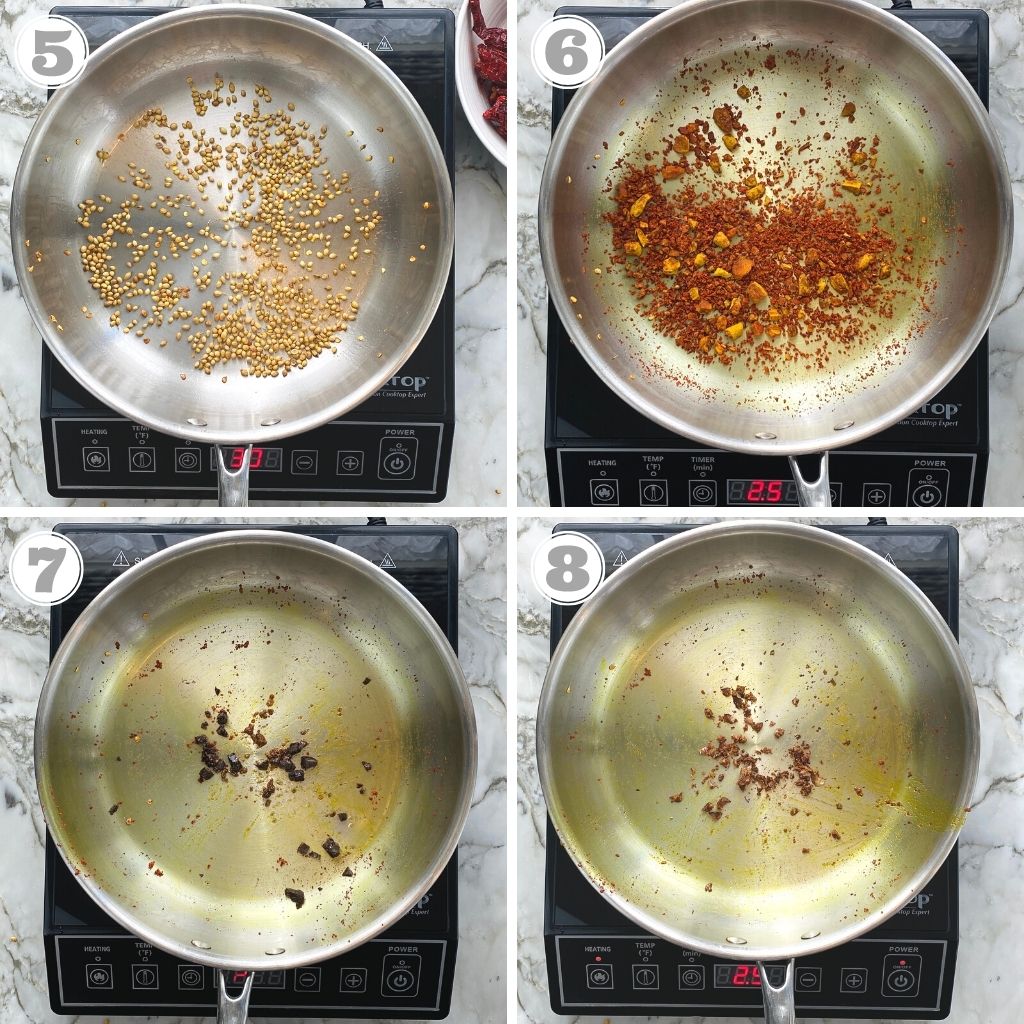
- The next spices to toast are broken cinnamon sticks, cloves, black cumin seeds, cumin seeds, and the 2 types of cardamom. As you can see, you can mix in a couple of spices for toasting like I did with cumin seeds and cardamom. For each spice make sure that they are roasted until aromatic and hot to the touch (photos 9 - 12)

- Next toast the stone flower, fennel seeds, mace (break if whole by gently pressing with the wooden spatula) and whole black pepper (photos 13 - 16)
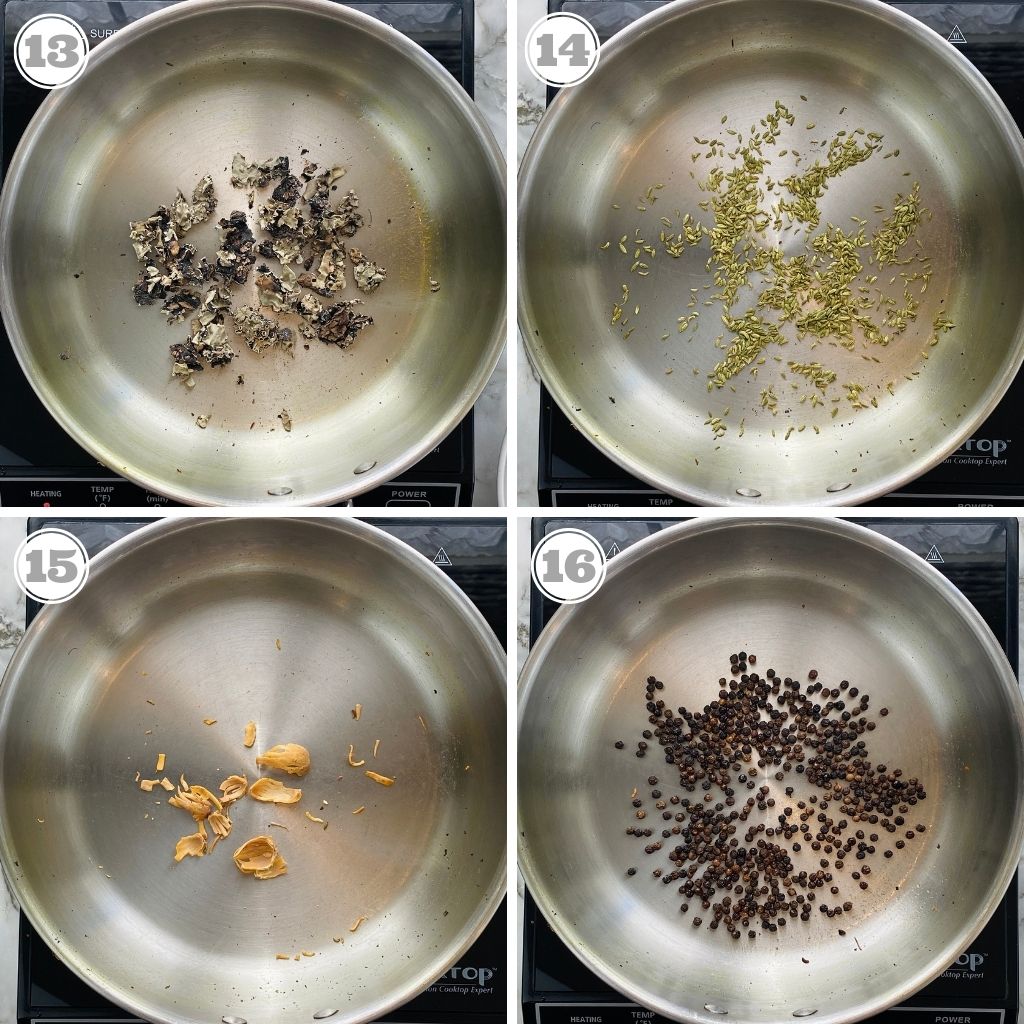
- Toast the last 4 spices - star anise, bay leaves, fenugreek seeds, and poppy seeds (photos 17 - 20)
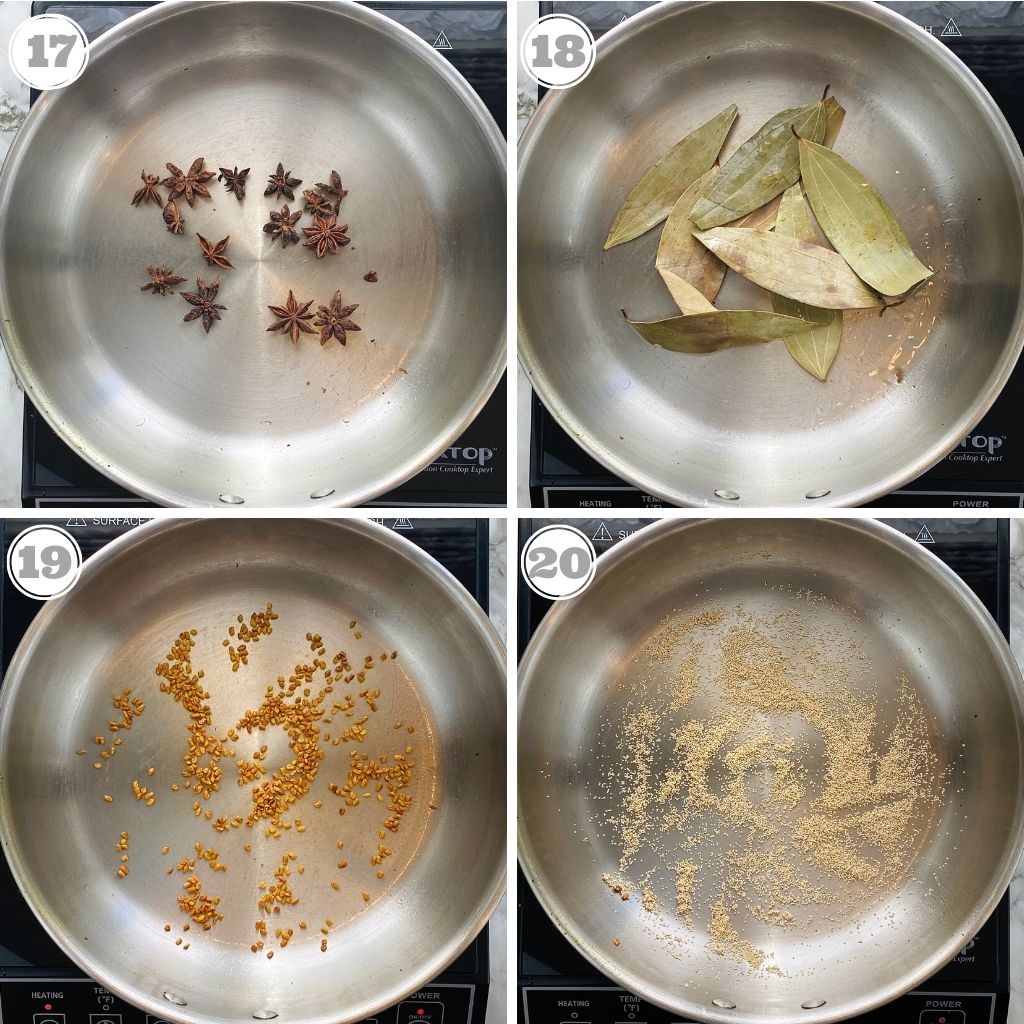
- Once all the spices are roasted, spread them on a large baking tray and allow them to completely cool down.
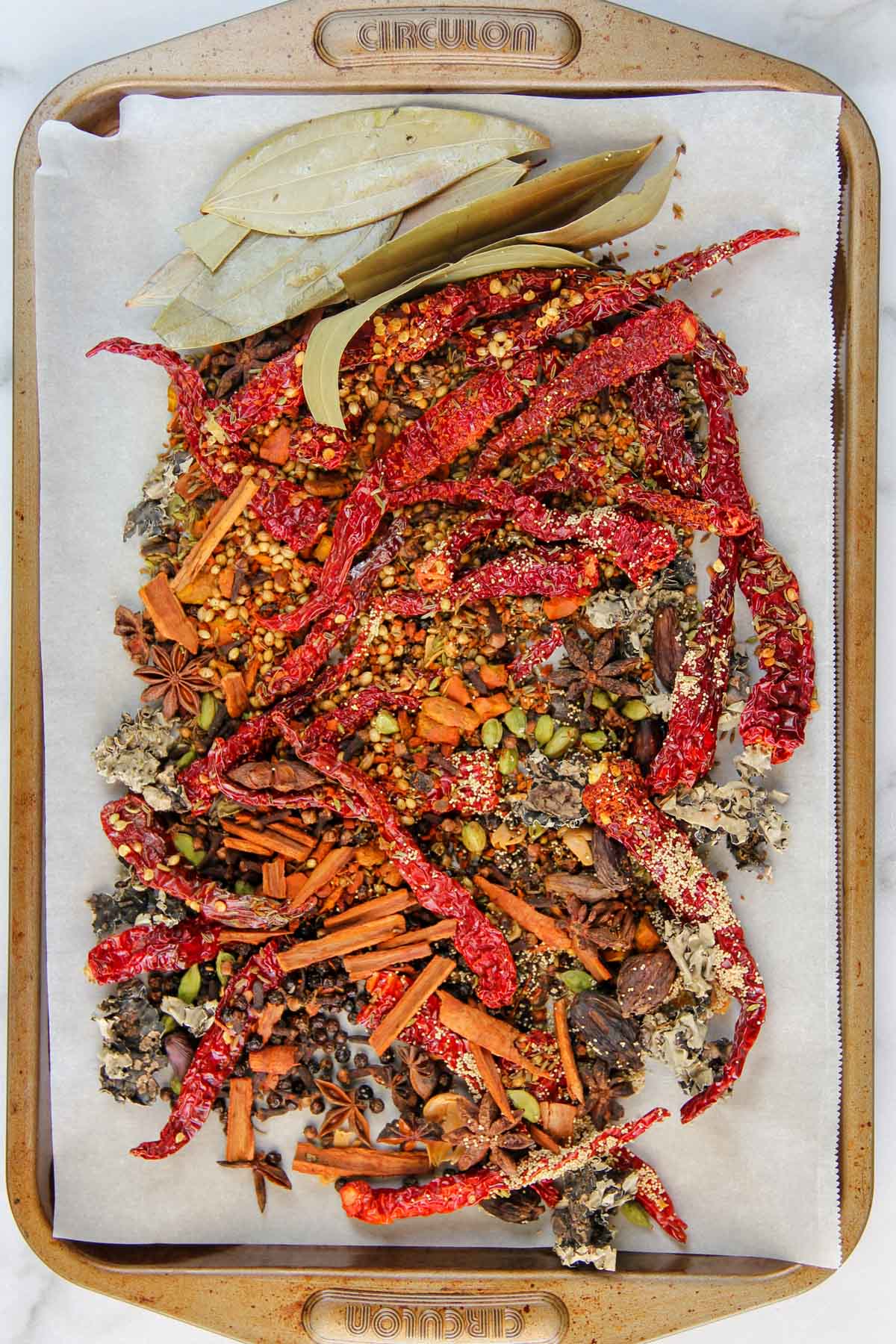
Grinding Spices
- Grind the roasted spices in a spice grinder or a coffee grinder in batches to make a fine powder. Sift the ground spice powder and return any remaining coarse spices back to the spice grinder.
- Repeat the above step for the remaining roasted spices. Depending on the spice grinder you have, you may end up with more coarse powder. Traditionally this spice blend is finely ground but you can also use the coarse spice blend in your cooking (photos 21 - 24)
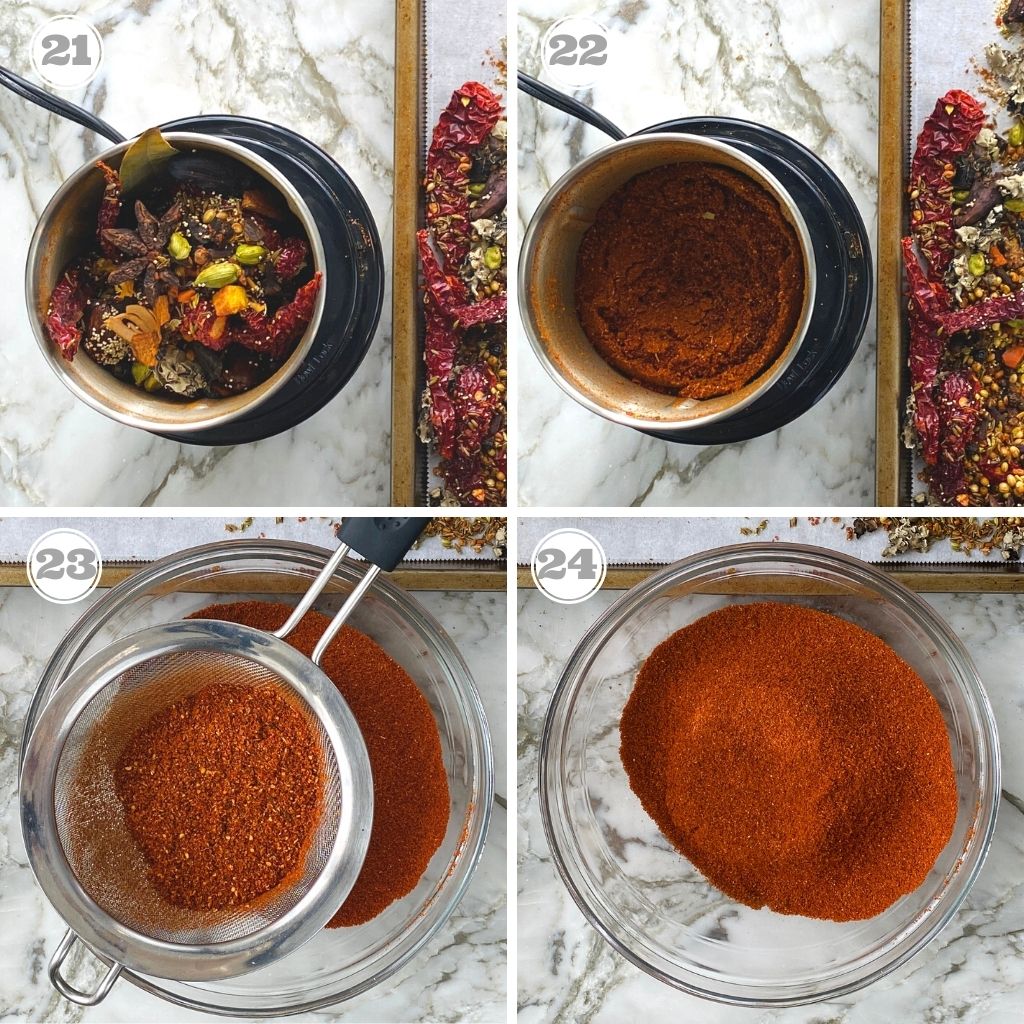
Storing
Store the sifted garam masala in an airtight container or a glass jar in a dry place away from direct sunlight. You can also refrigerate or freeze the garam masala for longer freshness.
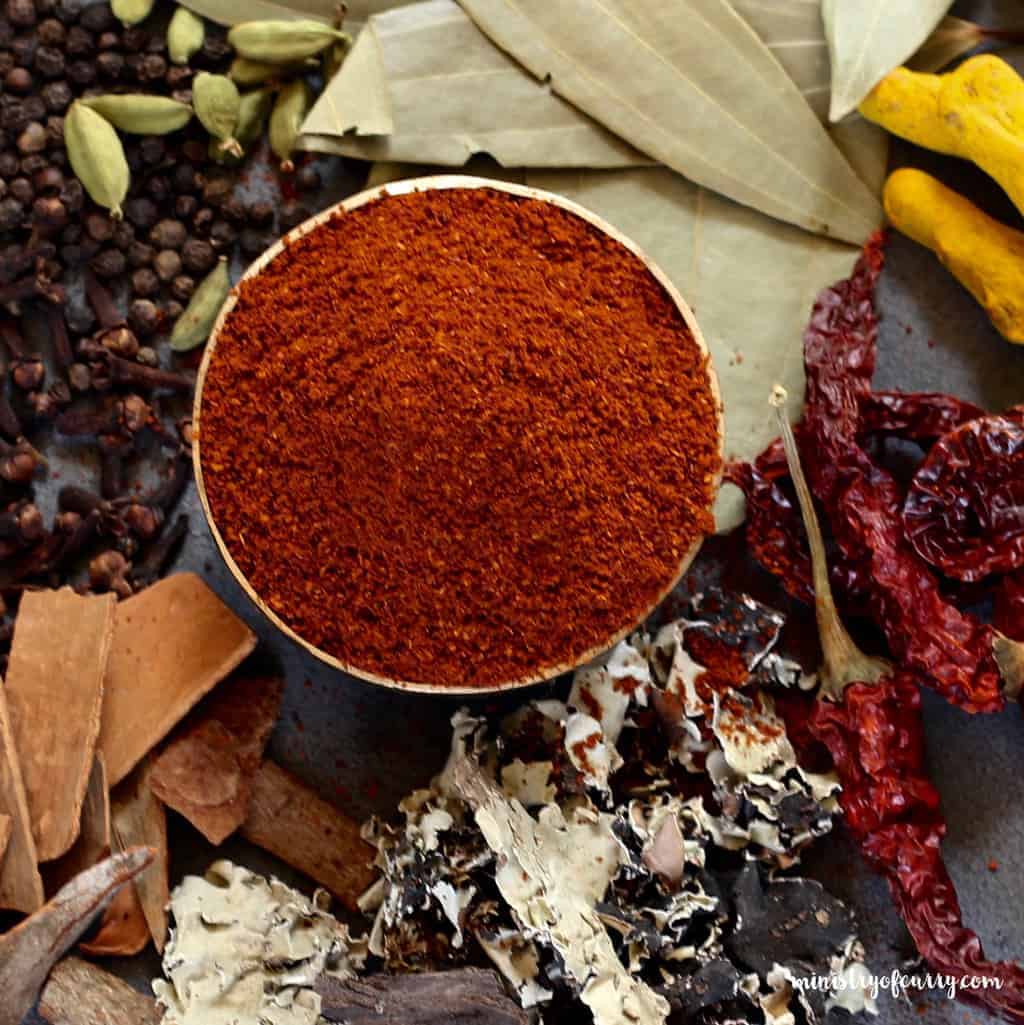
What do I use garam masala for?
Now that you have seen how to make this flavorful Indian spice blend, let's see how to use it! We love adding homemade garam masala to curries, rice dishes, and to lentils and beans like rajma, black-eyed peas, or brown lentils.
Notes: Since this recipe also includes red chilies you may not need to add extra chili powder. Remember that this garam masala is flavorful but not overly hot! So add more green chilies or red chili powder to your taste.
Substitutes and Variations
- A little bit of oil is often used to roast the spices which help them bloom and release aromas. But adding oil is optional and you may skip it altogether.
- I like to use the red dried Kashmiri chilies in this recipe which yields a vibrant red color without adding too much heat. You can also substitute with spicer dry red chilies instead.
- If you do not have whole dried turmeric, you can add 1 to 2 tablespoons of ground turmeric to the garam masala.
- In India, these roasted spices are taken to professional pounding machines known as Kandap Yantra. Getting that fine powdery texture at home takes a bit of patience. You may end up running the spices through the grinder a few times to get that fine texture of ground spices. However, it is completely ok to have your spice powder a bit coarser.
More Homemade Spice Blends
If you enjoy home cooking, you have to try making homemade spice blends that will elevate the flavors of any dish you make. You will be blown away by the taste as well as the quality if you compare them to store-bought spices. From my easy 5-ingredient garam masala to the homemade chana masala recipe, learn more about different spices and spice mixes in this cooking 101 guide.
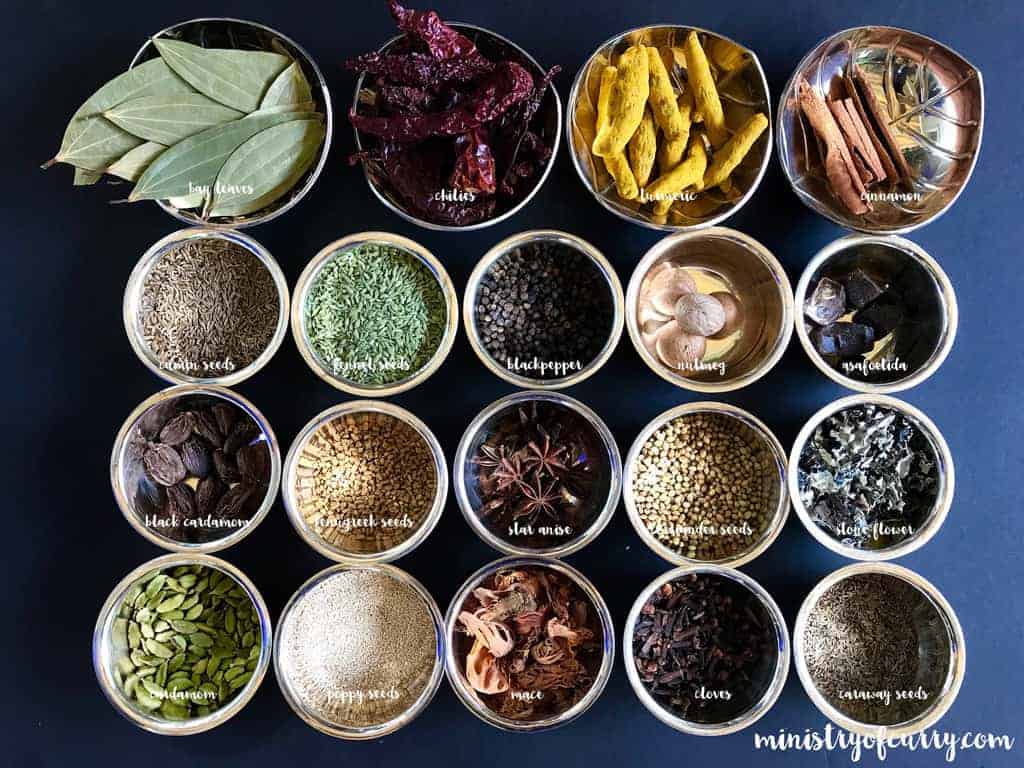
Garam Masala and Curry Powder are both blends of ground whole spices. Curry Powder is not common in India and is mostly seen in Japanese cooking. In India, Garam Masala is often used in combination with other dry and ground spices.
Depending on the spices used to make the blend you may need more or less Garam Masala. I recommend starting with 1 teaspoon and then adding more to taste.
The whole spices used in garam masala are roasted before grinding and hence it is not required to cook them again. Adding in the end also allows you to add per taste. If you are serving the dish to young children, you can reserve some food prior to adding extra garam masala.
Depending on the spices used to make the garam masala, it can make teh food hot. Spices such as whole red chilies, black pepper corn and cloves usually will add heat to the garam masala.
★ Have you tried this recipe? We love your feedback, Please click on the stars in the recipe card below to rate.
Recipe
Mom's Garam Masala
Equipment
Ingredients
- 5 pieces whole dried turmeric - halkund
- 1 tablespoon asafetida - hing
- ½ nutmeg - jaiphal
- 2 to 3 tablespoons oil **
- 25 dried red chillies - mirchi stems removed
- ½ cup coriander seeds - dhane
- 5 cinnamon sticks - daalchini
- 3 tablespoon cloves - lavang
- 1½ tablespoon black cumin seeds - shah jeera
- 1 tablespoon cumin seeds - jeera
- 10 black cardamom - badi velchi
- 1 tablespoon green cardamom - velchi
- 3 tablespoon kalpasi - dagadphool stone flower
- 1 tablespoon fennel seeds - badishep
- 2 tablespoon Mace - jaipatri
- 3 tablespoon black pepper - mire
- 10 star anise - badyan
- 8 bay leaves - tamal patra
- 1 tablespoon fenugreek seeds - methya
- 1 tablespoon poppy seeds - khuskhus
Instructions
- Using a mortar and pestle break the whole turmeric, whole asafetida, and whole nutmeg into smaller pieces, one at a time. Set the three spices aside.
- Remove stems of the red chilies.
- Heat a few drops of oil in a heavy-bottomed pan. Add the red chilies and roast them on medium-low heat for 2 to 5 minutes stirring frequently as they get aromatic. Take out the roasted chilies in a large bowl.
- Next, add the coriander seeds to the pan and roast they get aromatic making sure not to brown the seeds. Take out the coriander seeds on top of the roasted chilies.
- Add 2 to 3 drops of oil at a time and continue to slow roast each spice until it releases the aromas and is hot to touch. Keep adding each roasted spice to the bowl of chilies.
- Once all the spices are roasted, spread them on a large baking tray and allow them to completely cool down.
- Grind the roasted spices in a spice grinder in batches to make a fine powder. Sift the ground spice powder and return any remaining coarse spices back to the spice grinder.
- Repeat the above step for the remaining roasted spices. Depending on the spice grinder you have, you may end up with more coarse powder. Traditionally this spice blend is finely ground but you can also use the coarse spice blend in your cooking.
- Store the sifted garam masala in an airtight glass jar away from direct sunlight. You can also refrigerate or freeze the garam masala for longer freshness.
Video
Notes
- A little bit of oil is often used to roast the spices which help them bloom and release aromas. But adding oil is optional and you may skip it altogether.
- I like to use the red dried Kashmiri chilies in this recipe that yields a vibrant red color without adding too much heat. You can also use more spicer dry red chilies instead.
- If you do not have whole dried turmeric, you can add 1 to 2 tablespoons of ground turmeric to the garam masala.
- In India, these roasted spices are taken to professional pounding machines known as Kandap Yantra. Getting that fine powdery texture at home takes a bit of patience. You may end up running the spices through the grinder a few times to get that fine texture. Although, it is completely ok to have your spice powder a bit coarse.
♥ We LOVE to hear from you! Did you try this recipe? Please share your food photo with the hashtag #ministryofcurry on Facebook or Instagram, so we can see it and our followers can enjoy it too! Thank you and Happy Cooking
♥ Subscribe to our Youtube Channel for tasty and easy video recipes. Looking for more Instant Pot recipes? Check out our delicious Instant Pot Recipe board on Pinterest.


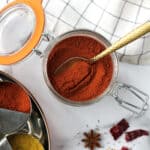
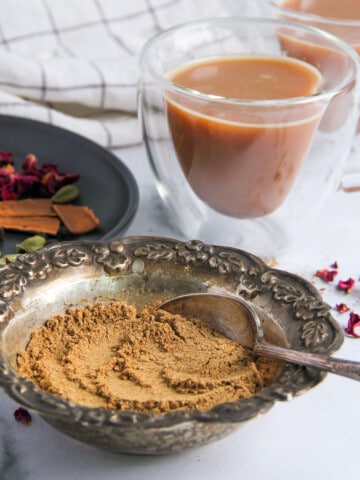
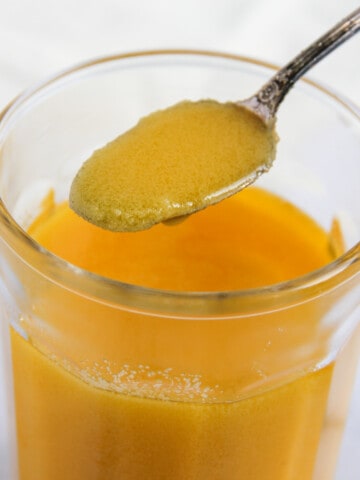
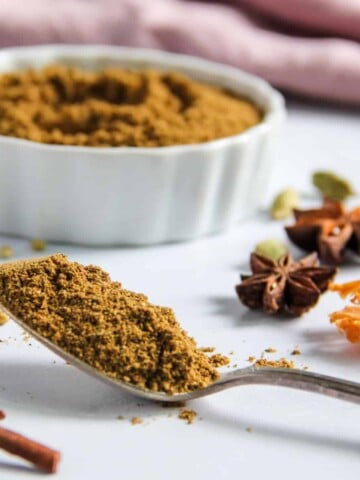
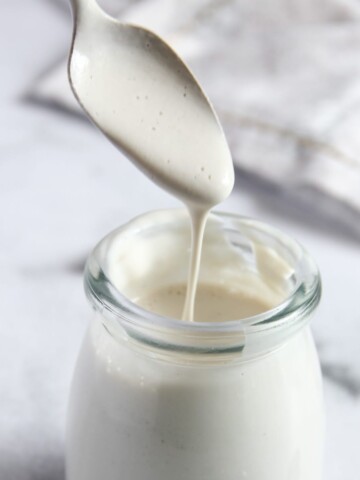
Logeswary says
Thankyou so much, so kind of you to share your family receipi. If I want to do about 5kg, can I just follow your receipi and increase the quantity
Archana says
I am not sure if doubling this recipe will make it 5K. I would suggest you try a smaller batch as shown in the recipe first.
Pat Parker-Roach says
I made a large batch to use as holiday presents for family and friends. The recipe states that it makes 1 lb. I increased it to 10 lb and then measured out each ingredient and weighed it for future reference. After completing the roasting and grinding I weighed the final product. It came to about 5.5 lbs. This is about 1/2 of what I needed to fill 70 x 4 oz bottles. The only variation I made with the recipe was substituting ground turmeric for the whole pieces. Grinding the whole tumeric pieces was beyond the capability of my electric blade grinder.
BTW - the finished product smells amazing and has a very nice complex flavor. Thanks!
Archana says
WOW! I am impressed that you made 10 lbs of this recipe to fill 70 bottles. To be honest, my mom still makes this garam masala for me. Even posting this recipe was a huge task for me especially here in the US to find all the whole spices and grind them to a fine powder.
@just.a.cooking.mom says
Amazing recipe! It took me weeks to collect all the ingredients, but it was worth it. My kitchen smells amazing and it is much richer and warmer than store-bought.
Hans says
I hope this is not too silly of a question. Are the spices roasted individually, or all together?
Archana says
Spices are roasted individially.
Claudia says
You are beyond blessed to have had the opportunity to learn directly from your Mom.
My mother guarded everything she did in the kitchen, never sharing any of her wisdom or experience with her children. I am going to take my son with me to a local international market to buy all the spices needed to make Butter Chicken, and show him how to make it from scratch. My birthday gift to him will be a jar of Garam Masala that we made together ❤️ I am of Polish ancestry, so i so enjoy diving headfirst into cuisines from around the world. I felt like i was right there with you and your Mom. Thank you.
Archana says
Thank you so much! Happy Birthday to your son, he is going to enjoy the Butter Chicken and what a thoughtful birthday gift!
Jessica says
Any tips on replacing the chiles? I have autoimmune disease and can't have anything from the nightshade family, but I am sorely missing Indian food.
Archana says
You can skip chilies altogether. Mom is visiting and I asked her, and she says it will still be good. Also If you like check out my 5 ingredient garam masala that does not use chilies - https://ministryofcurry.com/homemade-garam-masala-2/
Alex Lautensach says
Dear Archana,
Thank you for making Indian cuisine accessible to millions of non-Indians! You are truly serving humanity.
We have been using extensively your recipes in the instant pot book. However, what we found missing is a recipe how to prepare idlis in the instant pot. We recently acquired a stand of idli forms and are eager to use them.
If you have published such a recipe, could you kindly direct us to it?
Thank you for your help!
Best wishes in appreciation,
Alex & Sabina Lautensach
Archana says
Thank you Alex and Sabina. I do have Idli recipe - https://ministryofcurry.com/idli/ and it also links to a detailed recipe on how to make perfect fermented Idli batter.